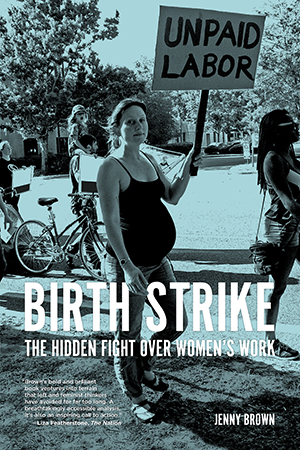U.S.-born women workers have effectively gone on a birth strike, and that’s freaking out an establishment fighting with itself over immigration policy and reproductive freedom.
By Jenny Brown
Socialist Forum
Fall 2019
The U.S provides very little support for parents—no paid parental leave, expensive childcare and college, unreliable health care that can bankrupt you, pay that requires both parents to work, and long working hours. These conditions are contributing to the U.S.’s lowest-ever birth rate: 1.72 children per woman, well below the 2.1 rate required for a stable population. But instead of taxing the rich to provide support for childrearing, as other countries have done, the U.S. employing class has been carefully avoiding the costs of reproduction of its workforce. These costs are instead pushed onto families, to be paid out of their strained wages. The level of exploitation has reached the point that U.S. parents, and women in particular, are having fewer kids. It’s an uncoordinated “birth strike” in response to all the unpaid work, stress, and exhaustion. And now there’s evidence the low birth rate is freaking out establishment think tanks and policymakers.
Immigration has always been the U.S. employing class’s answer to lower birth rates, so why won’t it suffice now? Immigrant workers arriving as adults substitute for the children U.S. women didn’t produce, and if they settle here permanently, may have children of their own. But now we’re seeing new levels of anti-immigrant fury while pundits and politicians plead with U.S. women to have more babies. This article will examine what is going on.
Instant Adults
Establishment Democrats have settled on immigration “for our country’s long-term growth strategy” and as “a source of economic vitality and demographic dynamism.” Most elite Republicans agree. “Immigrants and their children have made up over half the workforce growth in the country for the last twenty years,” said Federal Reserve Bank of Dallas president Robert Kaplan in response to a crackdown on immigrants early in the Trump administration. “Because of aging demographics . . . if we do things that limit sensible immigration, we are likely to slow GDP.” Likewise, the Koch brothers, hardly known for their concern for the well-being of immigrants, have been pushing Congress to allow people brought to the U.S. as children to stay.
However, immigration has caused discomfort as well as joy for the ruling class—a contradiction that has been a recurring theme of U.S. history. In the 1870s, and again at the beginning of the twentieth century, immigration and the birth rate were often discussed in the same breath: If native-born women don’t have more children, we’ll be overrun by immigrants. Fear of Slavs, Jews, Catholics, and Chinese has been replaced with fear of Latinos and Muslims, but the alarmist claims endure: They’re disloyal, they bring foreign ideas, an alien religion, class conflict, crime, drugs, they won’t assimilate, they’ll come to outnumber “real Americans.” Still, distaste for outsiders always seems to yield when employers need their brain and muscle.
These days, while Democrats largely embrace immigration as an answer to low birth rates, the Republican establishment is split. One faction supports immigration, while the other complains that immigrants will demand government benefits, vote for Democrats, and bring class war. Even the pro-immigration side worries that the flow of immigrants is unsustainable politically, and lately they worry that the supply will run out due to declining birth rates in the immigrants’ countries of origin.
Pro-immigration Republicans are quite candid that they favor immigration to compensate for the low U.S. birth rate. In a 1997 New York Times op-ed the late Ben Wattenberg, of the pro-corporate American Enterprise Institute, identified immigration as a cheap way to cope with an aging U.S. labor force. “The median age of legal immigrants to the United States is twenty-eight,” he wrote. “These are men and women who have been raised and educated on someone else’s nickel. They typically pay into Social Security and Medicare for about forty years before drawing upon them.”
Wattenberg let slip a truth that is often hidden in the immigration debate: Immigration is a colossal rip-off of the labor and resources of the mothers, parents, communities, and countries the immigrants leave behind. This reverses the mainstream narrative that immigrants are a drain on the economy and should be grateful to be here. In fact, Mexico, India, the Dominican Republic, and other sending countries are subsidizing U.S. employers by raising these workers to adulthood.
Wattenberg favors pro-natalist tax policies, but they’re too slow for him. Even if tax breaks for parents are increased, he writes, “a baby born nine months from now won’t even start paying into life’s Ponzi scheme for a generation. . . . And that happens only after we spend a lot of money to raise and educate the child. . . . A quicker fix would be ‘instant adults.’ As it happens, they are available: immigrants.”
Former Florida governor Jeb Bush is almost as frank in Immigration Wars, a book dedicated to changing U.S. laws to increase immigration: “America’s population is shrinking and aging. We need more immigrants to stem that debilitating demographic tide. . . . A demographic time bomb . . . is shaking the sustainability of our savings for retirement, the viability of the entitlement system, and our ability to create robust economic growth.”
Jeb Bush recognized that much of his party’s base opposed increased immigration, but when he wrote his book in 2013 he hoped to avoid the venomous split that occurred in 2006. Then, the U.S. House passed a bill to punish and expel immigrants who were without proper papers. Twelve million would have become felons. The Senate favored a program that allowed immigrant workers to stay, while creating expensive hoops for them to jump through—also known as a “path to citizenship.”
President George W. Bush backed the more pro-immigration Senate bill, which put anti-immigration pundits in a froth. Patrick Buchanan accused the president of allowing an “invasion” and wrote in his book State of Emergency that President Bush would be remembered for a “dereliction of constitutional duty.”
Fox News host John Gibson waded into the debate by instructing white viewers to “Do your duty. Make more babies!” Gibson raised the specter of a Latino majority in the United States: “By far, the greatest number [of children under five] are Hispanic. You know what that means? Twenty-five years and the majority of the population is Hispanic.” His logic may have been faulty, but his projection of Fox’s racial anxiety was precise.
After he was criticized for racism, Gibson backed off, implying that children of any color were needed: “To put it bluntly, we need more babies . . . or put another way, a slogan for our times: ‘procreation not recreation.’”
Along with the Bushes, most corporate owners favored some form of immigration bill and were angry at House Republicans who opposed the Senate bill on “cultural” grounds. Wall Street Journal editorial page editor Paul Gigot grumbled that the anti-immigration right “isn’t even rational anymore.” His wing of the Republican party, more concerned with corporate labor force requirements than the national origin of that labor force, supported a bill that would broaden a work permit system, euphemistically called a “guest worker” program. As long as you are working, the system allows you to stay. If you are laid off or fired, you can be deported. Employers thus avoid paying for unemployment insurance for the workers they have discarded, and don’t have to face their political protests either.
Jeb Bush also emphasized “work-based” immigration and goes further, urging lawmakers to get rid of family reunification as a criterion for immigration. Family reunification makes it possible for immigrants to eventually bring close family members to the United States. But in keeping with their desire to import young adults and avoid paying for children or old people, Bush and his Immigration Wars coauthor, Clint Bolick, write: “Extended family members typically do not produce the economic benefits that work-based immigrants do, and they impose far greater costs. Many extended family immigrants are children, elderly people, or others who do not work[,] yet often consume … social services such as schooling and health care.” Instead, he urges that only the spouse and children of the immigrant should be permitted to follow them to the United States. Forget about your family, you’re here to work!
Others try to show that “work-based” immigration can create common ground between employers and xenophobes by assuring everyone that arriving workers would have no rights, no political voice, and no future guarantees. Daniel Henninger, another Wall Street Journal editor, argued: “I believe the Republicans and the right ought to find a way to create a guest worker program that is not an amnesty, it does not necessarily mean [immigrants] become citizens . . . they should be given temporary status so when the market turns, they can go back where they came from.”
But the differences have been too large to paper over, and immigration bills failed in 2006 and 2007. The drama was replayed in 2013 when a bipartisan Senate bill was blocked in the House.
For Mexicans, who make up the largest immigrant population in the United States, being told to “go back where you came from” is nothing new. Mexican workers have experienced several waves of welcome and ejection based on the needs of employers. They were welcomed as laborers during World War I to replace draftees sent to war, but when unemployment soared, they were ejected: “During the Depression, as many as a million Mexicans, and even Mexican-Americans, were ousted, along with their American-born children, to spare relief costs or discourage efforts to unionize,” writes journalist Nina Bernstein. “They were welcome again during World War II and cast as heroic ‘braceros.’ But in the 1950s, Mexicans were rebranded as dangerous, welfare-seeking ‘wetbacks.’”
It shouldn’t surprise us that the treatment of immigrant workers (like that of U.S.-born workers) reflects the needs of capital. When a boom comes, employers want access to a big pool of available labor so they can maximize profits. During an economic upswing, scarce workers have the power to demand more in wages. If their employers don’t accede, workers can easily find another job. Employers may pretend indifference to the demands of workers, but in fact they’re very attuned to the balance of power. As Economist Dean Baker writes in The Conservative Nanny State: “From the standpoint of employers, life is much easier when the workers are lined up at the door clamoring for jobs than when workers have the option to shop around for better opportunities.”
But recent immigrants, especially if they are undocumented, don’t have as many options as U.S.-born workers do, and this gives employers more power. Workers without the right papers can be threatened with deportation if they organize for better treatment or a union, and most can’t get unemployment insurance or other public assistance if they lose their jobs, so there is even more pressure on them to avoid irritating the boss. “Whenever a worker complained about not being paid their wages, or complained of sexual harassment or tried to form a union, all the employer had to do was call immigration, and they could deport away their problem,” explained union organizer Ana Avendano. The U.S. union movement increasingly recognized this phenomenon in the 1990s, and in 2000 the AFL-CIO, the United States’ primary union federation, took the position that all workers, no matter their immigration status, must have full rights to organize. They noted, “Newly arriving workers continue to make indispensable contributions to the strength and growth of our unions. These efforts have created new unions and strengthened and revived others, benefiting all workers, immigrant and native-born alike.”
Does Immigration Lower Wages?
Some politicians claim that immigration is the main reason wages have been stagnant in the United States for the last three decades. Rick Santorum launched a short-lived bid for the Republican presidential nomination in 2015 making this claim, and Republican Wisconsin governor Scott Walker and even Barack Obama as president suggested this. In fact there is a vigorous debate among economists about whether immigration lowers wages for U.S.-born workers.
“To many non-economists it seems obvious that a rise in population leads to lower wages,” writes David Card, an economist specializing in wage levels. But when economists compare areas with lots of immigration to those with little, they find that the effect of immigration on the wages of the U.S.-born workforce is slight. Card argues that the reason immigration doesn’t lower wages for the existing workforce is that immigrants are also spending money and generating demand for goods and services, which creates additional jobs. As a result, the demand for workers goes up, creating upward pressure on wages. Card says the presence of immigrants in an area also attracts employers to build plants or invest in companies. So the general effect of immigration on native wages, he argues, is neutral or positive.
Some economists have detected a negative effect on wages. One study estimated that the pay of low-wage workers was reduced by as much as 9 percent by competition from recent immigrants. But Card argues that you can’t blame low U.S. wages on immigration, because other forces have been much more powerful. Among these forces are a federal minimum wage that doesn’t adjust for inflation, leaving workers perpetually behind; the churning of people from job to job due to automation; periodic recessions that cause lots of unemployment, driving everyone’s wages down; and the main determinant of wage levels: worker bargaining power through unions. Wages have been driven down for all U.S. workers by the destruction of unions: 35 percent of the workforce was represented by unions in the mid-1950s, now, that number is 11 percent. These factors dwarf any effect of immigration.
Immigration is favored by employers, not because it drives down wages for all workers, but because immigrants themselves are cheaper to hire. And an influx of immigrants can quickly increase the size of the labor force in boom times, when corporations get desperate for additional workers.
Some employers have used recent immigrants to fill low-wage jobs after they destroyed unions. The meatpacking industry is a good example.
Starting in the 1930s, meatpacking workers (many of them Eastern European immigrants) were able to improve pay and conditions in their plants by unionizing. By the 1970s, the dominant meatpacking corporations were regulated by union contracts that set wages and safety standards across the industry. But in the 1980s, upstart meatpackers like Iowa Beef Processors built smaller plants in rural areas to compete with big urban facilities. These companies automated more of the process, reducing the need for experienced workers, and kept unions out. In response to this cut-rate competition, the big unionized employers started their own union-busting. They closed plants, laid off their longtime union employees, and moved the work to non-union shops with lower pay and a faster work pace. Any unionization efforts were met with brutal retaliation. As conditions in the plants became more dangerous and oppressive, more immigrants were hired while some U.S. workers, who had more options, left. In some cases, plant managers deliberately recruited undocumented workers because they knew they would have more power over these employees.
The conditions in many meatpacking plants now resemble the barbaric pre-union days, according to a report by Human Rights Watch. When the union had power, injuries were in line with other manufacturing jobs, but now meatpacking is the most dangerous factory job in the United States. In any year, one-fifth of workers can expect to be injured or made ill. Workers have to quickly wield sharp knives and operate saws in slippery, cold conditions leading to severe cuts and severed appendages. Forced overtime means exhausted workers are more likely to slip up. Machines designed to grab carcasses can grab the humans trying to clean or unjam them, leading to horrifying deaths, while deadly fumes kill others. Training is minimal—one new hire was told, “Do what the guy next to you is doing”—and safety equipment and procedures are junked to speed production. “Meat and poultry industry employers set up the workplaces and practices that create these dangers, but they treat the resulting mayhem as a normal, natural part of the production process, not as what it is—repeated violations of international human rights standards,” Human Rights Watch concluded.
It was the destruction of unions in the meatpacking industry that resulted in lower pay and dangerous conditions, not the presence of immigrant workers. The answer is not to kick immigrant workers out, but to bring unions back in, as the workers did after a sixteen-year battle at the giant Smithfield pork processing plant in Tar Heel, North Carolina. In response to the union drive, the employer fired undocumented workers and tried to blame it on African American workers and the union. Despite these divide-and-conquer tactics, the workers won by building unity across lines of language, race, and immigration status. But because U.S. labor law is weak and even the weak laws go largely unenforced, this plant is a brave exception.
Headaches for the Employing Class
For now, U.S. employers seem to have found a partial solution to declining birth rates. Young, healthy adults come to the United States, saving the expense of childcare, education, and health care. Many are pushed into the low-wage workforce where employers can make maximal profits, while workers on skilled work visas bring down the cost to employers of hiring highly educated workers. When the economy tanks, they can be deported, or at least denied unemployment insurance, food stamps, and Medicaid. For the employing class, what’s not to like?
Relying on immigration is causing headaches for employers, however. The first headache is what employers would call “class war.” As the AFL-CIO resolution noted, immigrant workers, including those without papers, have led or contributed to many of the significant labor struggles of the last thirty years: meatpackers in North Carolina, taxi drivers in New York City, janitors in Los Angeles, port truckers in Long Beach, farm workers in Florida, and domestic workers all over the country, to name a few examples. Perhaps this is because class consciousness is more prevalent in their countries of origin than it is among U.S. workers, who have been taught from a young age that the United States doesn’t have classes, or if there is a working class, it is defined by taste in vehicles and music rather than common exploitation. Immigrant workers of color additionally can become united around their shared experience of racist mistreatment. This tendency of immigrant workers to organize against rotten conditions is one of the reasons employers are wary of immigration as a solution to their demographic worries.
And there’s another problem with immigrants, from the standpoint of Republicans. When elections come around, those who can vote (the studies usually focus on Latino people) show a definite tendency to be pro-labor, anti-war, and more Democrat than Republican. For example, after the 2006 immigration debate, the Latino vote went much more strongly toward Democrats, who were seen as defending the rights of immigrant workers. Anti-immigrant Republicans fear that a growing Latino voting bloc would lead to a permanent Republican minority. John O’Sullivan, National Review editor-at-large, made the case: “Of course the Democrats will support legalizing twelve million illegal low-paid workers and bringing in millions more. Low-paid workers vote Democrat. They are simply recruiting new constituents. . . . Democrats will gain something like a net four million new voters within three or four election cycles and millions more with each passing decade.”
Then there are power structure fears that the supply of immigrants may run dry. Jeb Bush noted uneasily that “the Mexican birth rate is declining and now is barely above replacement level.” He suggests that the United States is in competition with other countries for highly educated immigrants and needs to make it easier for them to come here or they’ll go elsewhere, like Canada or Chile. Another population alarmist, Jonathan Last, wrote that “Relying on immigration to prop up our fertility rate . . . presents several problems, the most important of which is that it’s unlikely to last.” Last laments that countries with low fertility rates don’t usually have a lot of emigrants. “In Latin America, the rates of fertility decline are even more extreme than in the U.S. Many countries in South America are already below replacement level, and they send very few immigrants our way. And every other country in Central and South America is on a steep dive toward the replacement line,” Last wrote.
Additionally, immigration has created political problems for Republicans among their voters. While these politicians encourage anti-immigrant bigotry in public, their actual policies are more concerned with the workforce demands of large employers. This gap between word and action has left an opening for anti-immigrant demagogues like Donald Trump, who rode anti-immigrant anxiety all the way to the White House, promising a wall to keep out Mexicans and a ban to keep out Muslims.
Finally, immigration isn’t making up for low birth rates. “In many rich countries, worker-hungry businesses are eager for more immigrants,” suggests the Wall Street Journal. “But to stabilize the elderly share of advanced countries’ population would require an immediate eightfold increase from less-developed countries. . . . This isn’t politically feasible given the resistance that even current levels of migration have generated.”
The basic problem for the establishment is that immigration will not satisfactorily solve their demographic woes. Even now it is causing them messy political problems and, more alarmingly, it may prime the workforce with workers who have greater class consciousness. This is why we’re now seeing open demands that U.S. women have more children, such as when House Speaker Paul Ryan burst out with “We need higher birth rates in this country” in December 2017, or Ross Douthat appealed for “More Babies Please” in the New York Times. And finally, there are signs everywhere that the employing class hopes to increase unplanned births in the U.S. by making it harder to get abortion and birth control. With this context in mind, we can start to understand these looming reproductive freedom fights not just as a culture clash, but as labor struggles.







